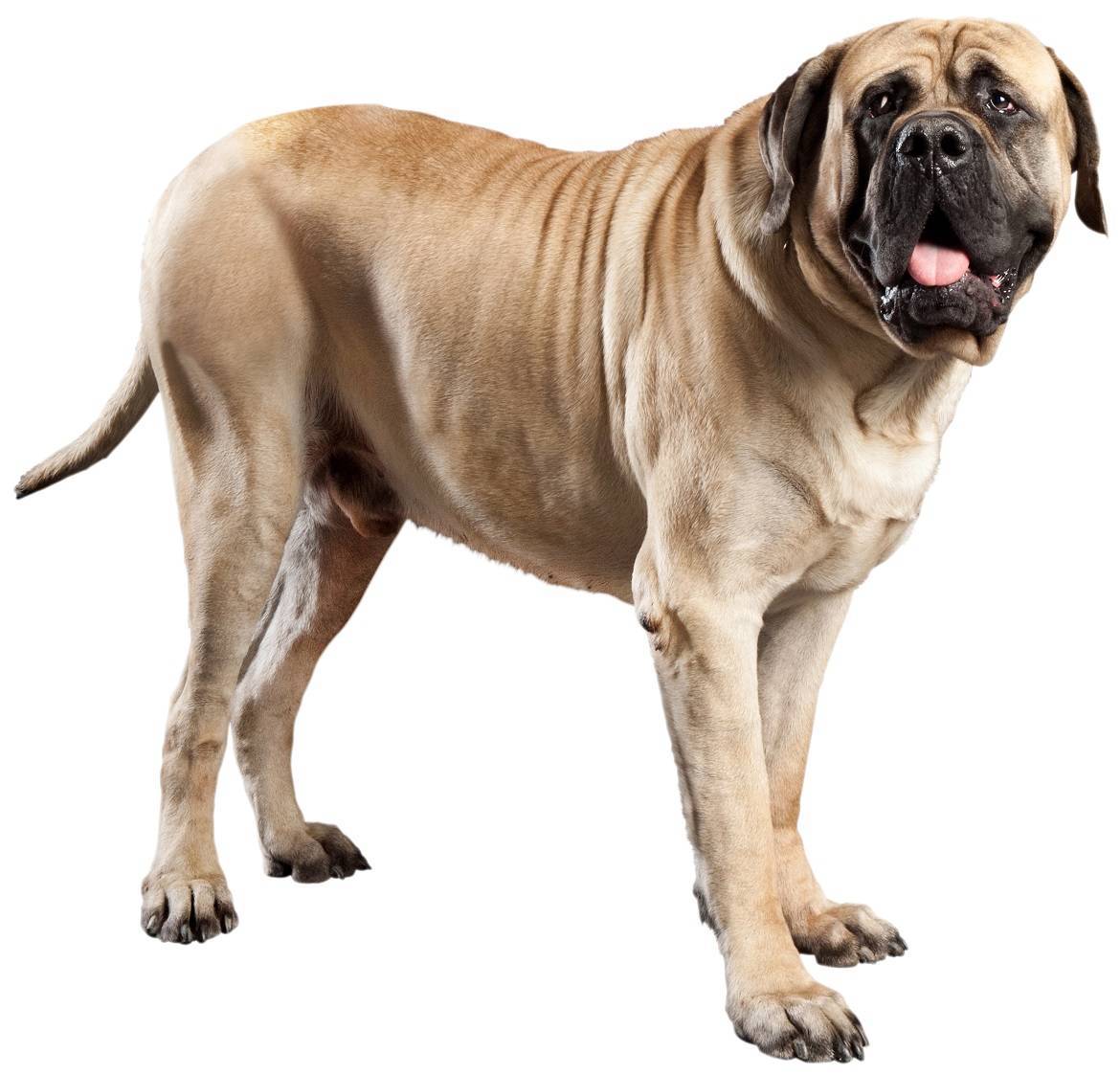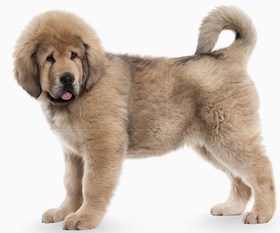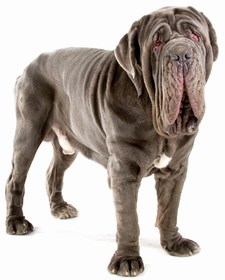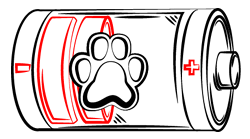
Paws ‘N’ Pups Quickview
Size
| Energy Level
| Trainability
| Paws ‘N’ Pups Rank
|
Characteristics
| Physical Characteristics: Height: 27-30” Weight: 120-230 lbs. Energy Level: Low – Moderate | Colors: The American Kennel Club recognizes the Mastiff in the following colors:
Black masks are common. |
| Health & Longevity: 10-12 years Breeders screen for the following conditions:
Cystinuria is an inherited kidney defect which leads to kidney stones. Seizures and cancer are known in the breed, as is gastric torsion (bloat), a life-threatening condition if immediate veterinary intervention is not sought. | |
Temperament & Train-ability
The words from the Mastiff’s standard sum it up well; dignity vs. gaiety, grandeur and good nature, courage and docility. Mastiffs are one of the most ancient of breeds and hold the place as the largest dog in the world. Others may be taller, but for size and mass, none surpasses the Mastiff. Living with a Mastiff is not for novices or timid people; apartments and condos are unsuitable, although calm as adults, this enormous dog needs room just to move around. Mastiffs are not prone to barking without reason. However, leave a Mastiff alone too much, and the barking and destruction they can wreak is massive. Mastiffs love to chew, so it would behoove you to provide many suitable (i.e. large) chew toys. Generally polite dogs, some Mastiff lines produce timidity and extreme shyness; in others, aggression exists. Choose your breeder carefully. Some Mastiffs are good with other animals, but some are very aggressive, particularly those of the same sex.
Mastiffs typically treat strangers with polite aloofness, but will step between you and another if they see potential threat; he will escalate if he feels the need. Because of this, watchfulness should not be encouraged; let him intimidate by his size and presence alone (which he will) rather than by his behavior. Clean dogs by nature, Mastiffs are usually easy to housetrain. However, be prepared for copious amounts of drool, slobber and gas. A simple drink at the water bowl can turn your kitchen into a lake.
Mastiffs have fairly low exercise requirements, a daily walk usually satisfying them. Sometimes a little lazy, they may not be motivated to go on that walk, but it is important for their good health. They are not suited as a jogging or running partner. In addition to modest exercise, the Mastiff needs mental stimulation and social contact (lots of social contact) to be happy. Mastiffs are the perfect height for counter surfing, so diligence is needed to keep food well out of reach. Mastiffs usually love children, although toddlers and frail, unsteady seniors can be easily knocked down with just a bump. Just as your dog will need careful socialization to learn appropriate behavior around children, your children must be taught how to properly interact with your Mastiff. Never allow children to sit on, attempt to ride or pull ears, etc. Children should be taught how to recognize when a dog needs a break and give them space.
Despite their size and imposing appearance, Mastiffs are sensitive creatures; harsh treatment should be avoided if you want to maintain your dog’s trust. You will succeed in training your Mastiff anything they are capable of through positive reinforcement methods, patience, and cooperation, not by outmuscling him. Mildly stubborn, Mastiffs may need some repetition to learn something, but they respond to patient and respectful handling. Mastiffs must receive early and ongoing socialization to learn that normal everyday people and things are not a threat. Some Mastiffs must continue to be consciously socialized their entire lives in order to feel confident. You will want to train your Mastiff for husbandry behaviors such as nail trimming, bathing and cleaning ears; there is no forcing a reticent Mastiff into the tub. Manners will also need to be thoroughly trained, as they can be quite bouncy and jumpy when young.
Grooming
Mastiffs have an easy care short double coat. They are, however, heavy shedders. Weekly brushing with a curry or soft bristle brush will keep skin and coat healthy and excess hair in the house to a minimum. During their spring and fall coat “blow”, daily brushing will be needed. Care should be taken to keep any wrinkles and skin folds clean and dry or they can become havens for bacteria to grow. Your Mastiff’s flews (the hanging lips on the lower jaw) should be cleaned after each meal. Ears must be cleaned regularly, and toenails will need to be trimmed, as most Mastiffs will not wear their nails down even if walked on concrete. Teeth should also be checked and cleaned as necessary.
Diet
The amount of food a Mastiff will require can vary depending on age, activity level, and type of food fed. On average, they will eat 6-8 cups of food daily, fed in two meals; free feeding should be avoided. A high quality food should be fed, and one formulated for giant breeds is recommended. Many Mastiffs are prone to overeating and weight gain, which should be avoided by carefully monitoring food intake. A constant supply of fresh, clean water must always be available. Mastiffs are sloppy drinkers and usually leave lots of slobber behind; water bowls will likely need rinsing several times a day.
Looking for a Mastiff?
 Find A Mastiff Breeder |  Mastiff Puppies For Sale |  Adopt A Mastiff |
Cost
Mastiffs run between $1,200 up to $3,000. Occasionally, a Mastiff may be available through breed rescue. Whether you acquire a dog from a breeder or rescue, do your homework to be assured that the temperaments of the dogs are tested and sound.
Ongoing expenditures include the typical supplies, food, and regular vet visits. Additionally, you may need to invest in an extra supply of chew and food-dispensing toys to keep your Mastiff occupied and healthy. Remember, too, everything costs more with a large dog; beds, the amount of food needed, as well as veterinary procedures. Don’t forget to consider whether your automobile can safely accommodate an adult Mastiff.
Paws ‘N’ Pups Ranking
Paws ‘N’ Pups ranks every breed out of 4 with 1 being easiest to integrate into your life and 4 being the toughest – The lower the ranking the better.
Ranking takes into account a few basic factors such as cost, skill level needed, high vs. low maintenance, and how critical regular training is to success. The Mastiff rates a 3.5; their cost, and the skill and amount of time and energy required to raise and live with a Mastiff make them a challenging breed to own.
Breeds Similar To Mastiff
 Cane Corso |  Tibetan Mastiff |  Bullmastiff |  Neapolitan Mastiff |




